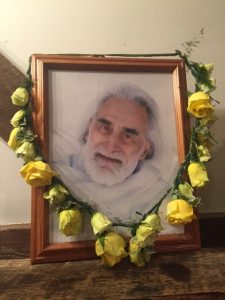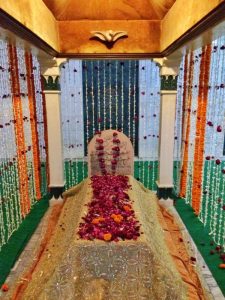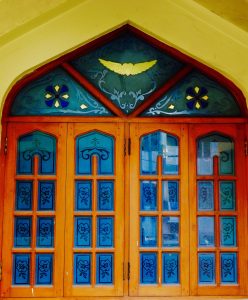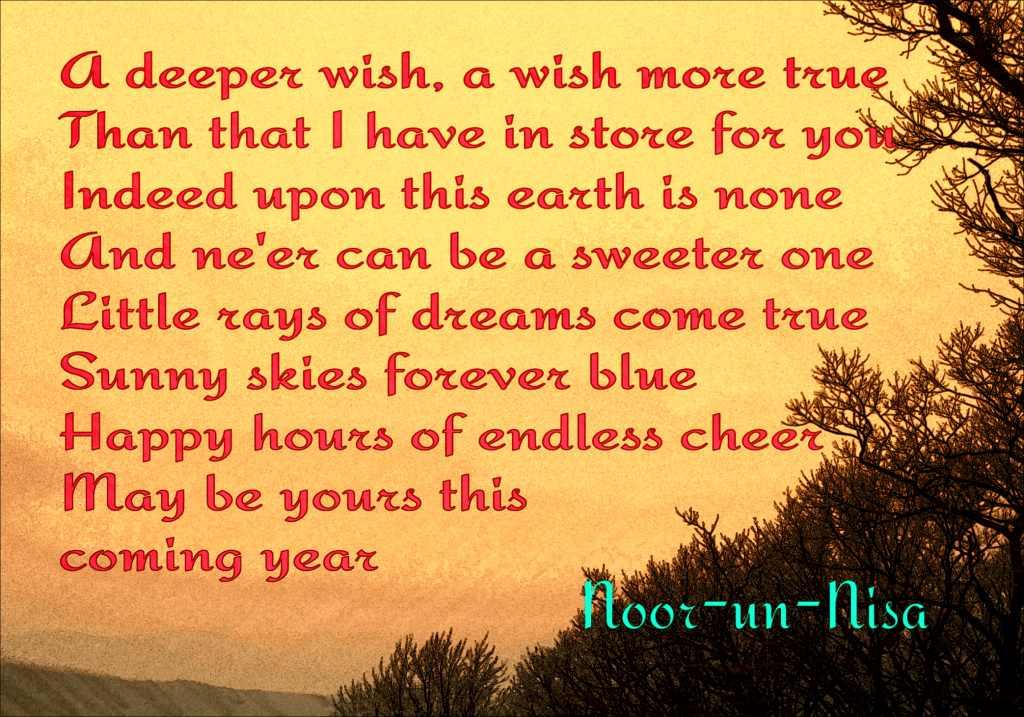14
2016by Misbah Noor
 On June 16 to 19, close to a hundred mureeds gathered at the Abode of the Message—with hundreds more all around the world attuned in heart and spirit—to celebrate the Urs and centennial birth anniversary of beloved Pir Vilayat Inayat Khan (qaddas allahu sirrahu), master of light and ecstasy. The Abode greeted us in all its summer glory! Flowers bloomed in jubilant hues and the afternoon breeze carried the humming of bees. The courtyard rung with laughter and the lively chatter of friends reuniting.
On June 16 to 19, close to a hundred mureeds gathered at the Abode of the Message—with hundreds more all around the world attuned in heart and spirit—to celebrate the Urs and centennial birth anniversary of beloved Pir Vilayat Inayat Khan (qaddas allahu sirrahu), master of light and ecstasy. The Abode greeted us in all its summer glory! Flowers bloomed in jubilant hues and the afternoon breeze carried the humming of bees. The courtyard rung with laughter and the lively chatter of friends reuniting.
As if it weren’t enough that we were gifted with a pristine sky and sparkling weather—a wish readily granted by the One—the sun and the moon colluded, too, in a truly cosmic celebration of our spiritual father and teacher. For the first time since 1948, the full moon rose at the same time as the June solstice, flooding the atmosphere with lunar light. Meanwhile, the earth’s Northern axis tipped towards the sun to bring us the longest days and shortest nights of the year. An apropos light-filled celestial tribute to our Pir Vilayat!
Towards the end of his life, as he lay in a hospital bed in Suresnes, Pir Vilayat confided to Pir Zia: “I won’t be able to travel anymore,” he said, “but I am working on seven planes of light and I will be with them that way.” His enduring devotion to mureeds, streaming through the subtle spheres, was palpable amid the heart-opening gathering, touching even those who did not meet him in his lifetime.
Together, on the hallowed grounds of the Abode, we paid homage to Pir Vilayat’s memory, to his pioneering work in the science of meditation, and to the Inayati Silsila. We listened to his favorite music, performed by many stellar musicians amongst us, and savored his spirit of “aliveness” through voice recordings of him leading meditations and singing Murshid’s poignant song, “Before You Judge My Actions.” We garnered blessings being in the presence of his family, his “twin soul” and close collaborator in work, Taj Inayat, and senior teachers and devoted longtime mureeds serving the Message.
In celebration of Pir Vilayat’s love for creatures of the sky, particularly eagles and falcons, we enjoyed a demonstration of birds of prey in the herb garden. Through the course of our days and evenings, mureeds shared stories brimming with love and lined with laughter and tears that conjured memorable mountain retreats and moments with Pir Vilayat. We visited the archives, traveling back in time via the conduit of diligently saved memorabilia. And we broke bread together in a Ramadan feast in the Rezak dining hall which was handsomely adorned with white tablecloths, flowers and candles. We offered our hearts up to the occasion and experienced the magic of discipleship threading us together, working its secret mystery in and through us. And, above all, we felt Pir Vilayat’s joy-filled presence.
To be sure, Pir Vilayat’s legacy encompasses the ecstatic meeting point of the two flames, earthly and divine. Echoed again and again over the weekend was the shared sentiment that Pir Vilayat was the quintessential embodiment of joy. And yet, as Pir Zia reminded us, his was not “… the simple naïve joy of those angels who have not touched their feet to the earth. It was another kind of joy. It was the joy of one who has walked on this earth and partaken deeply of the pain of this earth. It was a joy, in fact, that arose from the very crucible of human suffering.” Pir Vilayat’s joy was the joy of suffering transformed—by love. Murshid said, “The children of sorrow are the bringers of joy in the world.” Pir Vilayat became a bringer of joy, finding his path through healing music, especially through Bach’s B Minor mass, which towards the end of his life, he conducted in Dachau in memory of his beloved sister, Noor-un-Nisa Inayat Khan.
On Saturday evening, we were gifted with a glorious production of segments of the B Minor Mass, organized by conductor Tarana Sara Jobin of the Gulzar Class, and performed by a mix of professional musicians and Abode residents and community members. Some of us closed our eyes and listened; some of us tried to imagine the nature of Pir Vilayat’s own deeply devoted listening of this magnificent piece of music which follows the passion of the Christ—a listening described by Pir Zia as a “regenerative, illuminating meditation.”
Proceeds from the concert benefited the Hope Project in Delhi, founded in 1980 by Pir Vilayat to serve the needs of the desperately poor slum dwellers in the vicinity of Nizamuddin Dergah. The Hope Project, a cause close to Pir Vilayat and to the Inayti Order, was remembered throughout the weekend celebration with a pewter kashkul—the Sufi dervish’s begging bowl—placed in the entrance of the Meditation Hall to stimulate generosity. Cherished teacher and former head of the Esoteric School, Aziza, donated proceeds from her newly published booklet of memories of Pir Vilayat, too, to the Hope Project.
How felicitous that Pir Vilayat’s centennial anniversary and Urs were celebrated during the auspicious month of Ramadan—historically a time of retreat, prayerfulness and revelation. He was, after all, a Hanif, in the ancient tradition of mystics who were monotheists of a universal mind; who kept vigil, fasted, practiced silence and seclusion. Furthermore, elucidated Pir Zia, Hanifs were drawn to mountains and caves. And Pir Vilayat loved both the exaltation of the upper strata as well as the hermetic interiority of caves.
On Friday afternoon, a procession made its way in hallowed silence on foot and by car up the mountain to the site of Pir’s Pod. It was a pilgrimage to a space of illumined receptivity—geographical and spiritual—where radiant ideas and inspirations came to Pir Vilayat, which he transmitted in writing, and where he kept one foot in the ancient world and another apace with the changing times, through his computer. A lover of simplicity, he was at home here in the rugged setting of his pod and adjacent wooden hut. Standing there, we were reminded of a story Pir Zia shared earlier in the day of a visit he once made as a child up this very mountain to his father’s pod. He happened to glance at the electric socket in the wall of the pod and discovered, to his great surprise, a snake’s head peering out of it!
We crossed the threshold of the foundation where the former pod once stood. Clustering together in the compressed space, we prayed and sang. Afterwards, some of us visited the adjacent hut. Inside, Pir Vilayat’s high-backed chair greeted us, emanating an expectant, dignified air. Some of us wondered about Pir Vilayat’s wish to build a cave nearby— a dream that may yet, one day, manifest.
Over those concentrated days of devotion, our hearts widened and deepened. Exalted moments of flight during meditation shattered the narrow confines of our consciousness. We were borne aloft by the magnificent and lyrical invocations of Pir Vilayat, encapsulating “the harvest of the wisdom of the world.” How beautifully he opened the way to communion! We invoked, too, the six principles of alchemy, guided by Pir Zia in a meditation that offered a foretaste of “a larger music.” We were lifted into realms of light and joy, transported on the wings of breath, prayer and remembrance. And yet the ambiance was not without sobriety, a sobriety communicating the sheer wealth of our spiritual inheritance, brought forth in Pir Zia’s recitation of the Shajara, or chain of transmission. We sensed the living presence of the Silsia and remembered our responsibility as individuals to be vigilant, attentive and attuned to serving the highest truth in each unfolding moment.
The celebrations culminated in a breathtaking Universal Worship service on Sunday, June 19—Pir Vilayat’s centennial birthday and, fittingly, Father’s Day, too—the theme of joy and ecstasy threaded through an array of incandescent offerings. In his poignant, -soul-affirming sermon, Pir Zia invoked St Francis and Brother Leo, narrating through allegory, the path to joy amid—and despite—the trials and tribulations of our dense, earthly lives. “And if I am patient, and if I’m not upset, then is true joy. Then is the salvation of the soul,” he said, concluding his sermon by sharing a personal challenge—an adversarial impulse to tackle anyone who criticizes Murshid or the sacrosanct ones who dwell in his heart, but then, on hearing Murshid’s voice, If I am criticized, do not defend me, bowing in deference to Murshid, putting down his sword, and opening the doors of the sanctum. “And those swords that have been laid down are lifted up and hammered into ploughshares. And by the ploughing that is done seeds become grain. And the grain becomes the bread of pure joy!”
Clustered together beneath the chaddar—the blessed covering of Pir Vilayat’s tomb infused with the fragrance of roses—we were one family, merged in the spiritual being of our Pirs and our lineage. This symbolic sanctuary imprinted itself in our hearts. Here we will return, again and again, to nourish and fortify ourselves even as we seek the way ahead, as Pir Vilayat once did, seeking the path his father had ordained for him.
13
2016
TOWARDS THE ONE
THE PERFECTION OF LOVE, HARMONY, AND BEAUTY
THE ONLY BEING
UNITED WITH ALL THE ILUMINATED SOULS
WHO FORM THE EMBODIMENT OF THE MASTER
THE SPIRIT OF GUIDANCE
You are cordially Invited to the
12th Urs celebration of
Pir Vilayat Inayat Khan,
Sajjada Nashin of Pir-o-Murshid Hazrat Inayat Khan and Founder of the Hope Project
Friday, 17th June 2016
At Dargah Sharif Sufi Inayat Khan and
Dargah Sharif Pir Vilayat Inayat Khan
Program
Friday, 17th June 2016
8.00 am, “THE LEGACY OF AN EXTRAORDINARY MIND”
Meditation with Munir Voss at Dargah Sharif Pir Vilayat Inayat Khan
10.00 am, Fatiha and blessing of the Chaddar at Dargah Sharif Hazrat Inayat Khan Procession to Dargah Sharif Pir Vilayat Inayat Khan, Prayers and Offerings
followed by a program by and exchanges with the community of the Hope Project, at the Noor Inayat Khan Library, in honor and memory of Pir Vilayat Inayat Khan, on the occasion of his 100th birth anniversary
Organized by the Inayati Order and its President and Sajjada Nashin
Pir Zia Inayat Khan
Dargah Sharif Hazrat Inayat Khan
and Dargah Sharif Pir Vilayat Inayat Khan
The Hope Project Charitable Trust Founded by Pir Vilayat Inayat Khan
Pir Zia will be represented by Haji Aslam Hussain
Dargah Hazrat Inayat Khan and Dargah Pir Vilayat Inayat Khan
129 Basti Hzt. Nizamuddin,
New Delhi 110013
For further info contact carmen.hussain@gmail.com
18
2016By Humera Afridi
“Every activity of vibrations produces a certain sound, according to its dome of resonance, and according to the capacity of the mould in which the form is shaped.” (Hazrat Inayat Khan, The Mysticism of Music, Sound and Word)
On the morning of January 1, nestled in the Meditation Hall of the Abode of the Message—the site of so many beautiful teachings and powerful meditations—I listened with eyes open and the “ear of my heart” attuned as Pir Zia announced the change in name of the Sufi Order International to The Inayati Order.
Like water, ‘Inayati’ glided effortlessly, wave-like, on the breath. Possessed of an overall smoothness in sound, it conjured the delicate roundness of a pearl. Graceful, subtle, the new name immediately felt natural and right. Inayati brought to my mind, too, another image—that of a tall tree rising out of the earth, like the letter Alif, aspiring heavenward. Sitting across from the colored glass window inscribed with the message, Enter Unhesitatingly Beloved for in This Abode There is Naught but My Longing for Thee, I basked in the litany of evocative images and associations. Moments later, Juliet Capulet’s words arrived unbidden on my tongue:
“What’s in a name?” Juliet mused as she leaned out of her balcony in 14th century Verona. “That which we call a rose/By any other name would smell as sweet…” Her beloved Romeo, forbidden to her because he belonged to the feuding Montague clan, would surely “retain that dear perfection” no matter his name or clan. A name, after all, is merely a cloak, a superficial covering.
To an extent, Juliet’s words mirror how I feel about Murshid’s Tariqa—a rose/By any other name would smell as sweet. A change in name cannot alter the essence of Murshid Hazrat Inayat Khan’s vision. In its pure essence, his message remains fragrant as ever, enfolded in the hallowed sanctity of that “dear perfection” envisioned and articulated by him in the 1900’s.
And yet, it was with an immense sense of relief that I welcomed the new name, The Inayati Order. In an era of global capitalism, “Sufi Order International” connoted a large, multinational corporation to me, rather than a path of universal Sufism whose message is Love, Harmony and Beauty. If ever asked about my spiritual affiliation, I usually answered, “Hazrat Inayat Khan’s Tariqa” for it sounded more authentically true to me than “SOI,” a name that appears to highlight the executive function of the organization rather than its esoteric spirit. And from the perspective of my South Asian Muslim heritage, I found “Sufi Order International” to be broad and unspecific and surprisingly detached in nomenclature from the ancient languages of Sufism, even though many mureeds take on Arabic or Persian names after initiation.
The announcement unloosed an ease of recognition; untethered a joy of belonging. I admit to feeling lighter, more aligned, more at home knowing that I now belong to The Inayati Order. In Chapter IV, Volume II of The Sufi Message, Murshid says, “There is a great secret hidden in a name, be it the name of a person or thing, and it is formed in relation to the past, present and future conditions of its object…” Inayati holds the secret of loving-kindness, semantically in its meaning, and mystically in the potential of this exalted quality to manifest in one who concentrates on it. Inayati orients us instantly to our Murshid Hazrat Inayat Khan—the “inspirer of our Tariqa”—for in the fertile bed of his name are embedded the roots of this blessed Order. And in turning receptively to his name, we open ourselves to a transmission cascading through the ages in a sifted stream of golden light.
In the same chapter quoted above, titled “Name,” Murshid states: “All mystery is hidden in name. The knowledge of everything rests on first knowing its name… All blessings and benefits derived from earth or heaven are gained by mastery which depends upon knowledge, knowledge depending upon name.” I sense there is great blessing in the conscientious renaming of our Tariqa to The Inayati Order, for it draws us irrevocably closer to Murshid and to the essence of Murshid’s message. Invoking his name each time that we pronounce “Inayati Order,” not for a moment do we forget our Murshid and the spiritual lineage to which he is joined, and which enfolds us in its healing shade. Murshid says this, too: “The effect of the name is according to its use; the more it is used the greater the effect.”
He shares an example from the Holy Quran in which Prophet Muhammad (PBUH) is addressed by special names— “… each name having an effect not only on the life of the Prophet, but on his followers who adopted and worked mystically with any of these names,” adding that Sufis through the ages have experienced the mystical values of the various names. Likewise, our own intentional adoption of the name The Inayati Order (and, similarly, the new term of endearment of our Pir) heralds a new phase of spiritual evolution of our Tariqa. The change comes at a time when Murshid’s message of unity, and of Love, Harmony and Beauty is urgently needed in the world, and needs, too, to be reinvigorated within the ethos of our own Order.
Murshid did not set out to name an Order after himself; however, the guidance and inspiration that have informed Pir Zia’s decision to rename the Tariqa after him feel intuitively right. Murshid speaks of the mightier impact of the name that is bestowed by the Holy Ones—for the effect lies not just in the name but also on the will of the one who gave it. Murshid offers the example of his grandfather Maulabakhsh, who was the greatest musician in India in his time. His name, meaning “God Bless,” was given to him by a faqir who was enchanted by his music. After taking this name, Maulabakhsh was successful wherever he went and was “blessed with merit and reward, both of which are the rare gifts of God.” Just as a change in name can transform a person’s life, so, too, can it mold and sculpt the mystic body of a Tariqa, more powerfully so when the will and blessings of the Order’s lineage holder bolster the new name, a name which itself invokes the visionary and holy one who inspired and founded the order.
***
My understanding of name is that it is a form that gives birth to other forms, by shaping visible, manifest characteristics. Murshid says that we can understand the philosophy of form by studying the process whereby “the unseen life manifests into the seen.” In this mystery, I intuit the creative power of a name; its sound unleashing a field of magnetism that draws towards it, and evinces out of it, all that is needed towards fulfilling its ideal.
“As the fine waves of vibrations produce sound, so the gross waves produce light. This is the manner in which the unseen, incomprehensible and imperceptible life becomes gradually known, by first becoming audible and then visible; and this is the origin and only source of all form,” Murshid says in The Mysticism of Music, Sound and Word; Chapter V, “Form;” pg. 37. He further adds that all forms, no matter their plane of existence, are molded according to the law of affinity; every atom attracting towards itself the atom of its own element, and these atom groups together make up a form—a form that, I sense, is not limited to just a singular identity, but extends to a group identity, such as that of a spiritual Order.
In Philosophy, Psychology, Mysticism, Murshid says: “Sufis of all ages have followed this principle of making use of words which are suggestive of a certain sense, a sense which one wishes to bring out and make a reality in one’s life.” The audible sound of a sacred name when repeated impresses one’s spirit, “helping one develop that quality, that virtue, that merit, that power of inspiration” secreted in the name. The mechanism of one’s inner being is such, Murshid explains, that the more one repeats the name, the more living it becomes. But the mantric power resonates further, reflecting “upon the universal Spirit, and the universal mechanism then begins to repeat it automatically. In other words, what man repeats, God then begins to repeat, until it is materialized and has become a reality on all planes of existence.”
And so a yearning is set into place through the force of repetition, building towards a climax of fulfillment through manifestation—the audible form inflecting and molding the visible form. And yet, even as with every breath we approach closer to the ideal of realization, there is, of necessity, also a destruction, reshaping and reforming that take place to allow for the desired expansion towards the aspirational form.
In Path of the Seeker (Chapter 22; pg. 38), Khalifa Nargis Dowland writes: “Form is a vehicle or garment used by the soul of a person, either singly or collectively, in order to gain experience in a material world.
“The experience needed is for a purpose, and when that purpose is attained the form is no longer necessary; but before the purpose is achieved many forms may be used and eventually cast aside. From each there is some lesson to be learned, but no form should be retained after that particular lesson has been absorbed.”
To me, Khalifa Nargis’s words are prescient of our Tariqa’s change in name to The Inayati Order, heralding an evolution in direction, orientation, and focus of concentration. Even as I readily welcome and embrace the new name—for it resonates as an answer to my soul’s question— perhaps for others, especially those who have spent many years identifying with the former name, Sufi Order International, the transition to a new name may not be as smooth.
Here again, Khalifa Nargis eloquently articulates the discomfort that accompanies change: “Most of the pain and sorrow of life is caused by the breaking of form; and yet—strange paradox!—the human spirit progresses by, and only by, the breaking of form. It is the only way to find happiness, for while held in bondage to form of any kind, ‘caged, cabined and confined,’ it cannot rise to seek the freedom that is the breath of spiritual life: freedom to seek the return path leading to the Father’s house, from which it is exiled…” (Chapter 23; pg. 39)
I find my mind looping back to Juliet Capulet who would not be dissuaded from her love, would not surrender to the ways of a world that sought to separate her from her beloved just because of his name and clan. Juliet saw beyond the cover of form, drawn ineluctably to and intoxicated by the essence of Romeo’s being.
Here, again, I turn to Khalifa Nargis who writes in “From the Silence” (pg. 127): “Religions and messengers of God must have a name and form for use in a formal world, but what do forms matter to those who have eyes to see reality underlying all forms: the One and Only Being?” And, again, in Chapter 54 (pg. 223): “Differences exist not in the soul but in the forms or covers necessary for expression in a material world.”
By the mere fact that we inhabit the material world, we are undeniably subject to the influences of forms—forms that must and do change because of the very nature of existence. And so, we circle back to the importance of names and the “psychic affect” they have on their owners, their surroundings, and their sphere of influence. A change in name, Murshid declares, can entirely change a person’s life. With a maestro’s sensitivity to sound, he intimates a person’s entire life from the make-up of her name—“The rhythm of the name suggests the main thing in life, balance or its lack.” (The Mysticism of Music, Sound and Word; Pg. 35)
Certainly, I find that on saying “Inayati,” the breath flows uninterrupted by hard, staccato syllables. In the articulation of the name, I sense, too, a movement of breath reminiscent of a vinyasa flow, invoking an alignment of breath and being. The long “ee” sound at the end of the name hints at infinity, a generous and ongoing unfolding. And I can’t help but notice— and marvel—that the word “unity” in English feels homophonically related to Inayati!
Murshid says in The Mysticism of Music, Sound and Word, “…from the appearance of a certain name a person’s life, fate or character may be read in whatever language it may be written. For instance, a name beginning with I shows a steadfast and righteous ego, uniqueness and love of God and the pursuit of truth.”
***
And so, it is with my whole being that I orient myself to Inayati, the new name of our Order, heartened and fortified by all that Murshid and Khalifa Nargis say on name and form as I tread, with the luminous guidance of my Pir, this blessed path of spiritual liberty.
17
2016Alvida Hindustan! Goodbye to all of our Indian friends, family, and companions on the path. Remain blessed, one and all!



05
2016
02
2016Suluk’s Zindarud class graduated at Fazal Manzil in Suresnes on January 17, 2016.

07
2016Below is the program for the Urs of Hazrat Inayat Khan that will be held at his Dargah in New Delhi, February 4-6, 2016.
Hazrat Sufi Inayat Khan Urs Festival 2016
Thursday, February 4th :
7:00 pm – Sitar Recital Dr. Sunila Kasliwal
Vocal Recital Ms. Shahana Ali Khan
Friday, February 5th : Urs Celebration
9:00 am – ‘Call to Divine’ – Musical invocation, Km. Karunamayeeji
10:00 am – Procession to Dargah Hazrat Nizamuddin Aulia
Fateha Hazrat Sufi Inayat Khan and blessing of chaadar at Dargah Sharif Hazrat Nizamuddin Aulia with Rang Qaul and Qawwali. Ceremony under the guidance of Syed Mukhtar Nizami.
11:00 am – Procession with chaadar to Dargah Sharif Hazrat Sufi Inayat Khan.
Fateha.
Rang Qaul and Qawwali by Sons of Meraj Ahmed Nizami Qawwal and party Musical offering, Pir Shabda Kahn
12:30 pm – Lunch
4:00 pm – Universal Worship – a celebration of the unity of religious ideals
5:00 pm – Rudra Veena Recital Ustad Baha’uddin Mohiuddin Dagar
Langar distribution
6:00 pm – Dinner
7:30 pm – Santoor Recital Pandit Bhajan Sopori
Followed by Zikr in the Dargah
Saturday, February 6th :
10:30 am – Children’s Programme : presented by the students of the Informal School of the Hazrat Inayat Khan Memorial Trust and the Dargah Hazrat Inayat Khan Hope Project School
11:30 am – Tea
11:45 am – Welcome
Caravan : Invited guests include Pir Zia Inayat-Khan, Pir Al Haj Syed Ahmed Shah Chisthi Maududi (Herat), Sahibzada Syed Waris Hussain Chishty Moini (Ajmer), Pir Mohd. Mohamidul Hasan Jeeli Kaleemi (Hyderabad), Pir Shabda Kahn, Murshid Nawab Pasnak
1:15 pm – Lunch
2:30 pm – Music Presentation by students of the Hazrat Inayat Khan Music Academy under the guidance of Dr. Anis Ahmed Khan
3:30 pm – Tea
4:15 pm – Flute Recital Shri Rohit Anand
5:00 pm – Hindustani Vocal Recital Shri Amjad Ali Khan Kiranvi
6:00 pm – Dinner
7:30 pm – Dhrupad Recital Padma Shri Ustad Faiyaz Wasifuddin Dagar
Sunday, February 7th :
10:00 am – Commemoration Program in honor of late Khwaja Hassan Sani Nizami
Short Address by Khwaja Syed Muhammad Nizami
Vocal Recital Dr. Anis Ahmed Khan Nizami
Sitar Recital Shri Saeed Zafar Khan Nizami
Vocal Recital Ustad Iqbal Ahmed Khan Nizami
7:30 pm – Mehfil-e-Sama in memory of late Ustad Meraj Ahmed Nizami Qawwal :
Sons of Meraj Ahmed Nizami Qawwal and Tahseen Hussain Khan Nizami and party (Hyderabad)
03
2016We are writing to share with you news of great importance for our community and our work. This is news of a decision that is rooted in both reason and guidance; a decision that, we believe, will clarify the work that is ours to do in the world.
As you know, Hazrat Inayat Khan, our Murshid, brought the wisdom of Sufism to the Western world in 1910. He founded The Sufi Order in London in 1918 and The Sufi Movement in Geneva in 1923.
The word “Order” was, and remains, the standard English rendering of the Arabic word tariqa, referring to a Sufi path. The word “Movement” was a familiar designation in the early twentieth century for international spiritual organizations.
After Murshid’s death, his brothers and cousin successively led The Sufi Movement. To distinguish his own lineage and circle of mureeds, Murshid’s elder son Pir Vilayat revived the name “The Sufi Order” in 1968 (later updated as The Sufi Order International).
“The Sufi Order” is a nonspecific name: it refers to Sufism in general, but to no one tradition of Sufism in particular. When Murshid established his Order in the West, no other Sufi Orders were active in Western Europe or North America. A more specific name was therefore unnecessary and, in fact, would likely have caused confusion. This was still largely the case in 1968.
Today the situation is just the opposite: there are many Sufi Orders in the West—not to mention in Asia, where our Order is also spreading—and a nonspecific name is therefore a source of misunderstandings in the current environment.
In the history of Sufism, Orders have traditionally adopted the name of their founder in the decades following the founder’s death. Murshid understandably did not name his Order after himself, but long-established Sufi custom renders it natural and proper for us, who follow in his footsteps, to honor his memory and confirm our allegiance to his spiritual message by taking his name as the rubric of our work.
In consideration of these facts, and moved by a deep sense that the time has come, on this first day of the year 2016, we announce that The Sufi Order International will henceforth be known as The Inayati Order.
As a fuller designation the Order will be introduced as The Inayati Order: A Sufi Path of Spiritual Liberty. The name Inayatiyya will be considered a welcome synonym.
The Boards of the various national organizations have been informed in advance of this change. The trademark has been obtained, and we have acquired a number of relevant website addresses. It will, of course, still take some time to update all of our documents and printed and electronic materials in various languages throughout the world.
In adopting this name, we make no claim of exclusivity in representing Murshid’s Sufi Message of Spiritual Liberty. Indeed, we affirm all lineages, communities, and organizations linked to Murshid through initiation and devotion as our esteemed friends and allies in the Sufi cause.
The name Inayat means lovingkindness. May the name of our Order remind us always of this vitally important quality of being as we follow the path of service to God and humanity, amin.
Signed:
Pir Zia
The Message Council

